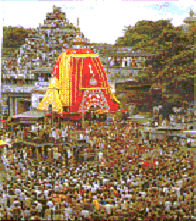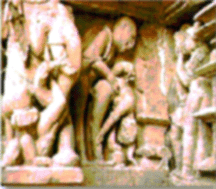|
In India, the establishment of the Muslim power around the 12th century brought in fresh principles and practices in the realm of architecture, which continued for the next 600 years. This Indo-Islamic architecture had three main divisions. They are:
The first, known as the Sultanate or the Imperial phase, refers to the structures raised by the Turkish and the Afghan Rulers who lasted for three and a half centuries. Delhi and its environs occupied the center stage.
After the death of Alauddin Khilji in 1316, the central power was very weak and this political independence encouraged the growth of individual trends in architecture. Local ideas and peculiarities were involved and it was called the provincial phase.
The third is marked by the brilliance of the Mughal Emperors. It flourished from around the center of the 16th century to the beginning of the 18th century. Akbar brought in an assimilation of Hindu and Muslim traditional elements in the field of architecture.
The Akbar's style can be seen in the fortress palace of Agra and Fatehpur sikri, his new capital near Agra. Of the administrative buildings the most distinctive one is the Diwani-I-khas or the Hall of the Private Audience, built in 1575.
Akbar built his own mausoleum near Agra, and his son Jehangir completed it in 1613. With Shah Jahan began the "Lyric Age" of Indo-Mughal architecture (1627- 1658). His Taj Mahal is a beautiful piece of vision in marble and precious stones. Later, his son Aurangazeb added some pretentious buildings, but by then architecture reached a point from where it can only decline.
The Taj in its entire entire splendor is regarded as the labor of love.
The surroundings of the Taj have been restored to the original designs of Ali Mardan Khan , a noble at the court of Shah Jahan. A red stone channel set between rows of Cypress trees accentuates the main vista. The main entrance is from the west, but there are two other entrances, from the east and the west. The main gateway is a large three-storey sandstone structure with an octagonal central chamber with smaller rooms on each side. The walls are inscribed with Quran verses.
The Makrana white marble of the Taj assumes subtle variations of light, tint and tone during different parts of the day. At dawn it assumes a soft dreamy aspect, at noon, it appears to be a dazzling white and in the moonlight, the dome looks like a huge iridescent pearl.
Rock cut Architecture
Hindu and Jain rock-cut architecture can be seen mainly at Badami, Aihole, Ellora, Elephanta, Aurangabad and Mamallapuram.
Badami has four cave temples executed at various levels of the sandstone hill.
Cave No 1 is dedicated to Lord Shiva, caves 2 and 3 are dedicated to Lord Vishnu, the Protector and cave 4 is a Jain structure.
Aihole has two rock-cut temples, one is of Jain origin and the other one is Brahmanical.
Ellora has 23 cave temples out of which 17 are Brahmanical and the rest six are Jain caves.
Southern Architecture
Mamallapuram or Mahabalipuram is noted for the famous Arjuna's Penance. The Pallavas of Kanchi initiated rock-cut architecture in the South. Their caves were of hard-granite. Narasimha Pallava built the coastal town of Mamallapuram near the present -day Chennai.
The Mamalla style cave temples were more elaborate. Monolithic Rathas and Vimanas belong to the Narasimha's period.
Mamallapuram is the site of some of the greatest architectural and sculptural achievements in India. Under the reign of Narasimha Varman, this seaport began to grow as a great artistic center. The beautiful cave temples and gigantic open-air reliefs carved from granite blocks date back to the7 th century.
The descent to the earth of the sacred river Ganges is the subject of the most important relief. About 20 feet high and 80 feet long, it contains over a hundred figures of gods, men and beasts. A cistern was provided at the top, which released water on special occasions to add a touch of reality to the tableau.
In early 8th century, work begun on the Shore Temple at Mahabalipuram. This temple was built to honor Lord Shiva. The Shore temple was built with granite blocks and it is the earliest known stone-built temple in South India.
Kanchipuram is one of the famous temple cities of Tamil nadu. It was the political capital of the Pallava rulers during the 7th and 9th centuries. The Kailasanatha temple is the finest structural project of the Pallava ruler Rajasimha. A large variety of Shaiva images adorn the outer walls of this temple. A polished lingam associated with Lord Shiva is enshrined within.
The Ekambareshvara temple is the principle shaiva sanctuary and its soaring gopuras dominate the city. Krishnadevaraya erected it in 1509. The temple is preceded by a long columned mandapam.
The Vardhamana temple is the most important Vaishnava temple in KAnchipuram. One of the two high towered gopuras resemble 12th and 13th century Chola projects while the other is characteristic of the 16th century Vijayanagar period. The main sanctuary enshrines bronze images of Vishnu flanked by his consorts. Some specimens of the Vijayanagara paintings are still preserved on the walls.
Odishan architecture
The temples of Odisha are of the Indo-Aryan style, which is distinct from the South Indian style. The main group of temples is concentrated in the town of Bhubaneshwar. A few miles from this town are the two large buildings in East India, namely, Puri Jagannath Temple and Konark Sun Temple.
The Jagannath temple at Puri was constructed around 1000 A.D. It consists of four structures, which constitute the fully developed Odishan style of Architecture. In colonial times, an elaborate set of representations was built around the Jagannath temple.
The grandest achievement of Odishan School of architecture is the Sun Temple at Konark, (1250 A.D) standing some 20 miles form Puri. It is dedicated to Lord Surya, the Sun God, who has been represented as riding his winged chariots drawn by seven horses.
The temple is therefore fashioned like a Ratha or Chariot and the base of the structure has 12 giant wheels, each nearly ten feet high. The entire structure is filled with sculpted forms.
Today the temple lies abandoned under the care of the Archaelogical Survey of India, unlike the Puri temple, which draws thousands of pilgrims all year round.
Central Indian Architecture
One of the most celebrated manifestations of central Indian architecture is found in a group of temples at Khajuraho. This is situated about 100 miles from Jhansi in Madhya Pradesh. There are around thirty temples here. These were erected over a narrow period of a hundred years from 950 A.D.
These temples represent a unique coincidence of religious emotions, abundant patronage, artistic genius and aesthetic sensibility. These temples have weathered the climate for over a thousand years.
The Khajuraho temples were built during the reign of the Chandelas. While some show marks of a Shaivite sensibility, others manifest the influence of Vaishnavism, Jainism and Tantrism. Each temple stands on a high and solid masonry terrace unlike other temples, which have a customary enclosure wall. The temples are not much large. They are elaborately decorated with sculptures. Other than numerous deities enshrined in the wall niches, there are attendants, maidens in very provocative postures, dancers, musicians, and embracing couples. On one temple alone about 650 figures are depicted. Many of these compositions display great sensuality and warmth. There are also scenes of explicit sexual activities. Sexual postures follow the Kama Sutra, the ancient Indian manual on the art of lovemaking.
Ajanta Cave temples
The cave temples of Ajanta are situated about 62 miles north of Aurangabad in Western India. The caves were discovered accidentally during military manoeuvers undertaken by the British officers in 1819. The 30 temples of Ajanta are set into the rocky sides of a crescent shaped gorge in the Inhayadri hills of the Sahyadri ranges. At the head of the gorge is a natural pool fed by a waterfall. The excavations were carried out over a span of 6 centuries. The earlier monuments included chaitya halls and monasteries. These date from the 2nd to the 1st centuries B.C. The sculptures contain an impressive array of votive figures, narrative episodes and decorative motifs. These cave temples of Ajanta provide the most complete illustration of Buddhist tradition.
|
















0 comments:
Post a Comment